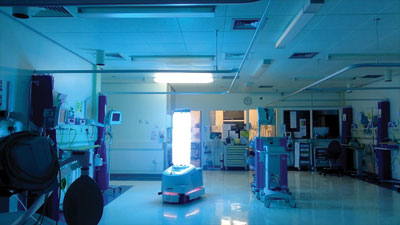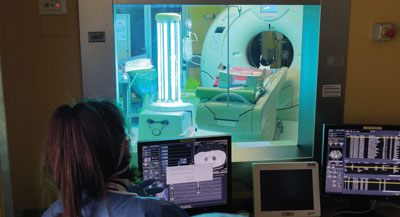- By Per Juul Nielsen
- May 31, 2020
- Channel Chat
Summary
By Per Juul Nielsen
As the global war against the coronavirus rages on, interest in safe, disinfecting technology that can kill the virus in hospitals is growing. Next-generation disinfecting robots created a few years ago for disinfecting hospital rooms using UV-C light have been gaining significant attention as a way to disinfect against coronavirus. In particular, the technology is enabling hospitals to protect patients, medical professionals, and frontline cleaning staff from infection while simultaneously bringing greater operational efficiency.
Using UV light is not a new idea. Since the 1870s it was known that ultraviolet light had an inhibiting effect on bacteria, and history shows that in 1895, Niels Ryberg Finsen used concentrated beams of ultraviolet light to treat patients with lupus vulgaris with some success. UV-C was also used to disinfect the municipal water supply of Marseille, France, in 1908, and Westinghouse developed the first commercial UV-C germicidal lamps during the 1930s to be used primarily in hospitals. After World War II, UV-C was used for sterilizing air in hospitals, kitchens, meat storage and processing plants, bakeries, breweries, dairies, beverage production, pharmaceutical plants, and animal labs. It became a major component in the control and eradication of tuberculosis, but the advent of antibiotics and vaccines meant that the technology was largely abandoned for decades.

The renaissance of UV-C light
Today, with the emergence of antibiotic-resistant bacteria and viruses that we cannot vaccinate against, this technology is seeing a renaissance. Scientific reports continue to underscore the benefits and importance of UV-C light in disinfecting. One study from September 2019 evaluating the effectiveness of improved cleaning interventions in hospitals reported that approximately 5–30 percent of surfaces remain potentially contaminated due to the inability of existing detergent formulations and disinfectants to kill certain kinds of bacteria.
In recent years, hospitals have been using UV-C light to sanitize rooms to reduce hospital-acquired infections (HAIs) with a cluster of UV-C emitting lamps that can be wheeled into a room. The lamps disinfect the room in an hour or less, reaching surfaces that may be overlooked by cleaning staff. However, the drawback is that this early technology requires a human to enter the room (between cycles) and move the UV-C emitting lamp from one position to another, so all surfaces, in theory, receive the maximum dosage of radiation. This calls into question the effectiveness, and raises the possibility of some surfaces that are either “shadowed” or further from the lamp potentially remaining infected.
The shadow effect
To understand the shadow effect, one need only look as far as the sun, by far the Earth’s most powerful source of UV-C radiation. The amount of UV-C generated by the sun every second is higher than all of the artificially generated UV-C in the history of UV-C disinfection combined. We all know that overexposure to the sun’s UV light can result in a sunburn. However, this is impossible at night, when the Earth blocks the light from the part of the planet facing away from the sun.
Similar to shadows, another law of light that complicates the use of UV-C as a room disinfectant is intensity over distance, which can be easily calculated using the inverse square law. The inverse square law dictates that to reach the same level of UV-C intensity (or germicidal effect) achieved at 1-meter distance, it is necessary to radiate for nine times longer from a 3-meter distance and 16 times longer from a 4-meter distance. UV-C intensity at 1 meter is 100 percent; therefore, the light intensity at 2 meters will fall to 25 percent (a quarter). At 3 meters, the intensity drops further to 11 percent (a ninth), and at 4 meters, intensity is only 6.25 percent.
When applying the idea of shadows and distance to a hospital room scenario, one can apply this thinking to the effectiveness of UV-C light. In fact, according to Professor Valerie Edwards-Jones of Manchester Metropolitan University “shadowing effects,” which reduce the UV-C intensity, and the distance from the contaminated surfaces can vary enormously, as she explained in her report, “UV-C Light and Coronavirus Statement.”

99.99 percent disinfection rate
Unlike their stationary counterparts that cannot reach shadowed areas or move close to all surfaces in a room, a self-driving robot has the ability to autonomously reposition itself multiple times and to disinfect during repositioning. These are critical factors in achieving the highest possible level of disinfection to eliminate bacteria and other harmful microorganisms.
Hospitals around the globe are benefiting from reduced shadowing and consistent exposure to every section of a room, resulting in a 99.99 percent disinfection rate, including from coronavirus.
Further, a major advantage of using robotic technology over manual disinfection systems is traceability, as the robot will repeat the validated room disinfection precisely again and again. If it does not, it will deliver a fail report, producing a much higher level of accountability than stationary lights.
The development of autonomous disinfecting robots started in 2014, when a group of Danish hospitals demanded a more effective way of reducing infection rates in hospitals. Through a collaboration of bacteriologists, virologists, and hospital staff from hospitals and robot developers, designers, engineers, investors, and business people from Blue Ocean Robotics, UVD Robots deployed its first autonomous robot at the Odense University Hospital in Denmark in 2018.
These self-driving robots can now disinfect a hospital room in about 10–15 minutes. UV-C light is also known to kill airborne microbes, which is becoming increasingly of interest. UV-C light is not harmful to humans in small dosages, and the light emitted through door cracks, etc., is not a health concern.
Further, a UV-light disinfection system also does not require changes in a room’s ventilation, and does not leave residue after treatment. There were no reports of damage to materials in the room during the use of UV-light disinfection systems.
A large volume of UVD Robots are currently in operation in close to 50 countries worldwide. They have now been deployed at hospitals in areas hard hit by the coronavirus, such as in Wuhan, China, and in Italy.
Operational efficiency
In U.S. hospitals alone, the Centers for Disease Control estimates that hospital acquired infections (HAIs) account for 1.7 million infections and 99,000 associated deaths each year. Further, according to research, patients who acquire infections from surgery spend, on average, an additional 6.5 days in the hospital, are five times more likely to be readmitted after discharge, and are twice as likely to die. Moreover, surgical patients who develop infections are 60 percent more likely to require admission to a hospital’s intensive care unit. Surgical infections are believed to account for up to 10 billion dollars annually in healthcare expenditures.
For some perspective on how autonomous disinfecting robots can help, last December, just before the coronavirus outbreak, an autonomous robot disinfected an entire hospital theater suite of 17 rooms including corridors. The disinfection comprised 60 separate disinfection positions. It was completed in fewer than two hours and involved fewer than 10 minutes of manual labor, underscoring how state-of-the-art robotic technology can drastically increase the coverage of automated infection prevention procedures within a theater setting. For the first time in history, theater personnel can routinely disinfect between procedures, as well as carry out a daily yet thorough disinfection of the complete theater suite, in less than two hours using minimal labor resources. This drastically reduced associated labor costs without sacrificing efficiency.
Beyond the pandemic
As we move beyond the coronavirus pandemic, it is likely that we as a global society will emerge with a very different sense of the need for disinfection. We will demand greater protection against not only hospital-grade infections, but new infectious risks to health in other environments.
While the coronavirus is pulling the effectiveness of UV-C light into the spotlight, self-driving disinfecting robots were already being successfully deployed to fight HAIs well before. Looking ahead, prevention will likely become central to controlling and eliminating the spread of diseases like coronavirus. We will see this disinfecting technology moving back into environments like those where UV-C light was being used in the 19th century and into more places, including factories, food storage facilities, prisons, schools, supermarkets, and airports.
Reader Feedback
We want to hear from you! Please send us your comments and questions about this topic to InTechmagazine@isa.org.


